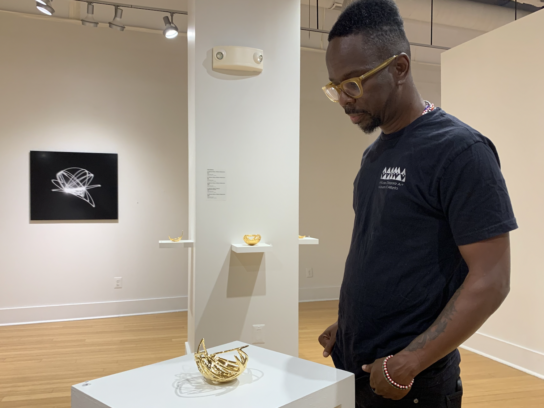
Hip-hop has been the soundtrack to Dr. Fahamu Pecou’s life.
Born in 1975, the self-described hip-hop interdisciplinary artist now wants to expand the way people think about the culture and music genre through both his own art, and his curated exhibits
Pecou’s Rockville exhibit, “Lyrics to Go,” molds works from two artists – Ebon Heath and Tahir Hemphill – to celebrate the hip-hop in new ways for the genre’s 50th anniversary.
“Hip-hop was born out of a necessity,” Pecou said.
In the 1970s, the Black community was struggling with social programs and budget cuts taking music and arts out of schools, Pecou said. Hip-hop emerged out of this as a way to express themselves, without traditional structures.
“It represents a space in a voice for people who were denied space and denied a voice,” Pecou said.
The two artists included in the gallery take different approaches to the genre – one focused on sculpture and typography and another using data analysis – but work together to inspect the lyricism of hip-hop.
“I really wanted something that was going to engage the poetics and language of of hip-hop and I felt that Ebon and Tahir’s work did that in both tangible and intangible ways,” Pecou said.
“Lyrics to Go,” is on display through Oct. 29 inside VisArt’s Kaplan Gallery in Rockville.
Ebon Heath
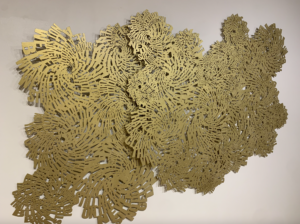
Ebon Heath’s sculpture based on Public Enemy’s song “Rebel Without a Pause”.
Letters have always surrounded Heath.
He remembers seeing graffiti everywhere, and trying to decode these hieroglyphics, while growing up in New York.
His father worked in a recording studio in Times Square, where Heath would see the big, old billboards.
Now letters are his career, his passion and his life.
Heath was a graphic designer for a design studio in New York City where he designed packaging and streetwear as hip-hop emerged into mainstream culture in the 1990s.
Eventually Heath started to work for himself, instead of clients, to further explore his love for letters and design.
Heath’s art transforms words into sculptures, jewelry and live performances.
“The sculptural work I make is trying to liberate words from the page and enable letters to express their content in three dimensional space,” Heath said.
In “Lyrics to Go,” Heath has five sculptures on display. The sculptures are all gold or silver painted baltic birch wood panels with hip-hop lyrics weaving around themselves.
The hip-hop artists who’s lyrics appear in the pieces include Marley Marl, Nas, Public Enemy and Boogie Down Productions.
Heath, who also turned 50 this year, has been able to watch the art for grow and evolve.
“Hip hop has really just been in the fabric of my maturity and my professional practice,” Heath said.
Because hip-hop is a relatively new genre, Heath said, people today have the unique ability to speak to and learn from the pioneers of the musical genre unlike most American musical forms.
His art is reflective of his practice to listen and appreciate the smaller details of the poetic language of songwriting.
The genre gave power to Black voices and is a biographical account of political and social justice movements, which Heath said has been almost forgotten in the United States.
Pecou said that this is the most prolific time of literature by Black people, and that he wanted his gallery to reflect the poetic innovation of language accomplished in rap lyrics.
That was until the 50th anniversary, when Heath saw the genre consumed by recognition, something he hopes last after this year.
Tahir Hemphill
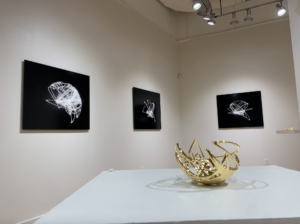
Tahir Hemphill’s art on display in “Lyrics to Go”.
Hemphill’s work combines art and technology. He uses code to analyze different aspects of hip-hop music.
In “Lyrics to GO,” Hemphill features multiple works derived from his analysis of locations in the art style. His 2-D and 3-D works map out every location mentioned by an artist.
Pecou said this part of the gallery represents an important geographical component to rap culture.
Pecou said that these rap songs brought previously unknown places into the mainstream.
“They’re talking about their experiences, and they’re inviting us into their worlds,” Pecou said. “This shows the literary impact of hip hop by writing not only people into the broader narratives, right, but places and spaces”.
Hemphill additionally mapped out connections between rappers and painters they mention in songs, such as Pablo Picasso and Jean-Michel Basquiat, shown in a large webbed map in the gallery.
Pecou said he would love for younger and older generations to see the exhibit and be challenged over how they view hip-hop.
“I just want to continue to open up the conversation and the dialogue around around hip hop. So that as we honor and acknowledge the 50-year anniversary, that we get a full view of the dynamic and complex ways hip hop influences our lives,” Pecou said.
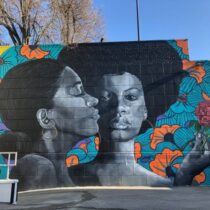
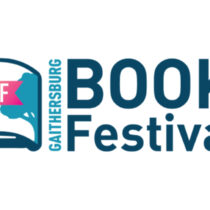
Comments are closed.